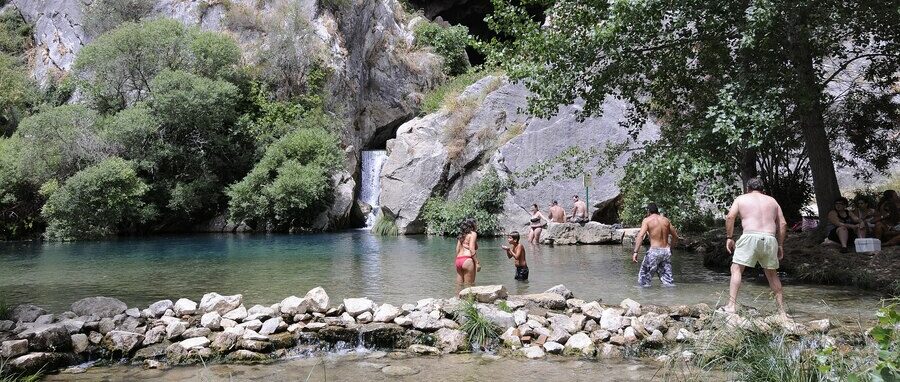As a country, we are slowly discovering our love for wild swimming, where you take a dive in rivers, lakes or natural pools and enjoy a swim surrounded by nature.
But in Spain, this practice has been popular for a very long time, even though the country is most famous for its beaches. For every beautiful beach on the coast, you will find that there is a stunning wild swimming location inland!
Spain-Holiday, the number 1 portal for finding the best holiday rentals in Spain, decided to help tourists discover these hidden wild swimming spots by making a ranking of the favourite swim locations of the Spanish!
The ranking was made using the searches on Google by Spanish people, to find out which ones are the most searched for. Are you ready to discover some of the most magical places in Spain?
- Lagunas de Ruidera | 50,000 searches per month
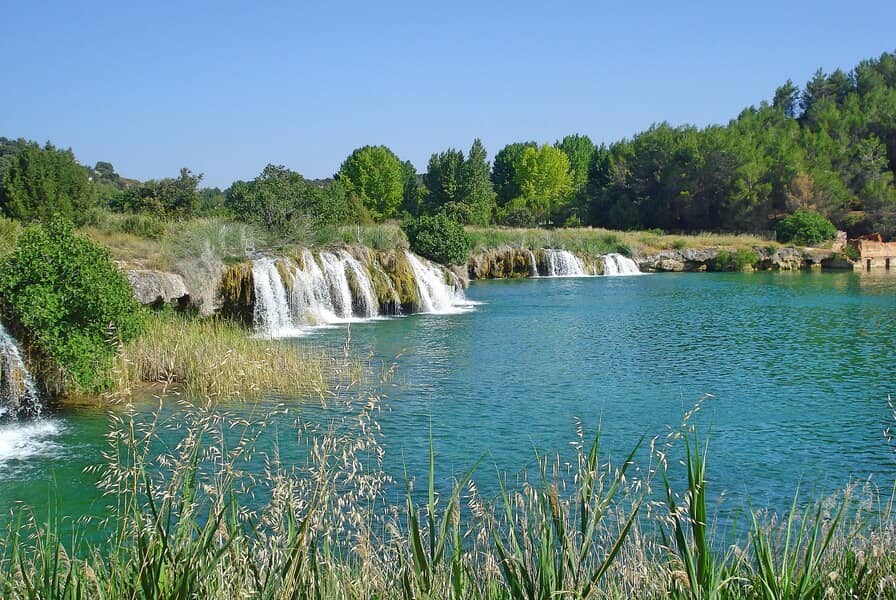
The Lagunas de Ruidera are a collection of 15 beautiful lagoons and lakes connected by waterfalls. Located in the Albacete province, the lagoons are a protected area where you can enjoy a swim surrounded by an incredible landscape!
The incredible biodiversity attracts not only swimmers but also birdwatchers, who try to spot the elusive Bolinelli’s eagles that have made their home in the park.
Because of the immense size of the park (almost 4 hectares), there is plenty of room for a lot of other activities besides wild swimming: kayaking, fishing and SUPing are all permitted in the Lagunas de Ruidera park. There are also many hiking routes you can follow to discover the local flora and fauna. The Lagunas de Ruidera is a perfect spot for a day trip, with plenty to see and do!
Parque Natural Lagunas de Ruidera
Address: Chorro de la Minas, 17, 02611 Ossa de Montiel, Albacete
Coordinates: 38.95941111, -2.90038889
- Pantano de San Juan | 27,000 searches per month
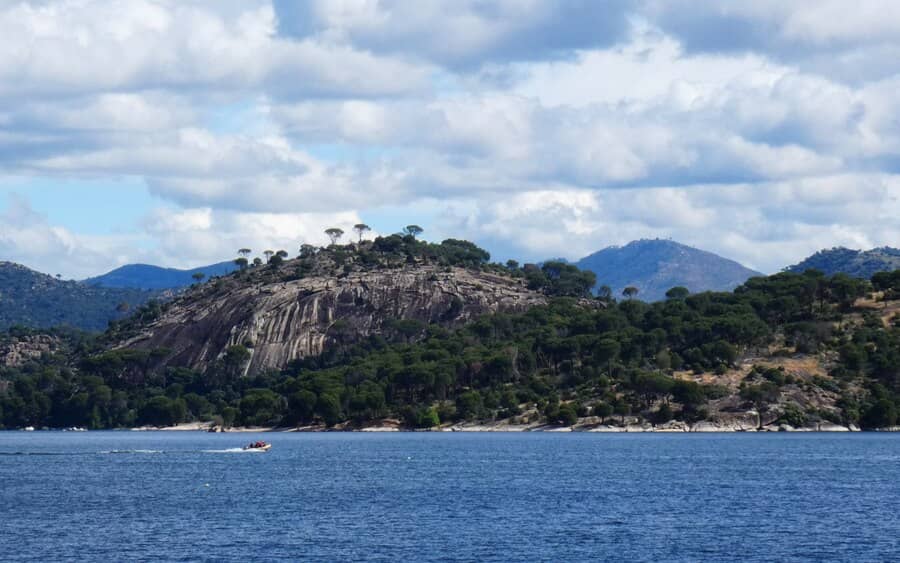
The Pantano de San Juan is a reservoir located to the west of Madrid, near the towns of San Martín de Valdeiglesias and Pelayos de la Presa.
This stunning natural location is also called the beach of Madrid, as it is the nearest large body of water to the capital where swimming and water sports are allowed. Surrounded by hills and forests, the Pantano de San Juan boasts 14 kilometres of beaches where you can enjoy a day out.
Depending on what you fancy, you can opt for Playa Virgen de la Nueva, which is best for swimming, or El Muro, where you can find the Nautical Club of Madrid with its jetty.
For the more daring among us, there are plenty of climbing routes allowing you to scale the cliffs at Lancha del Yelmo, on the eastern side of the reservoir.
And this is only the tip of the iceberg! Why don’t you visit yourself to discover everything there is to enjoy at the Pantano de San Juan?
Pantano de San Juan
Address: 28696 Pelayos de la Presa, Madrid
Coordinates: 40.3667, -4.3333
- Fuentes del Algar | 26,100 searches per month
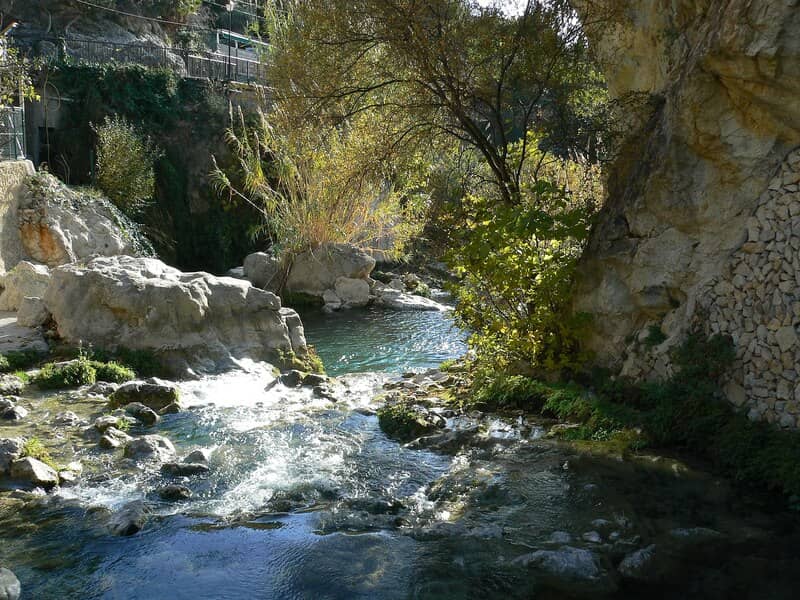
The Fuentes del Algar or Fonts de l’Algar are a natural oasis near Benidorm on the Costa Blanca. It is composed of a series of waterfalls and naturally formed pools where you can enjoy a refreshing dive.
The local government decided to add facilities to the area and charge a (small) entrance fee. They also make sure that the Fonts de l’Algar are conserved, protected and maintained to keep this natural wonder in its pristine condition for generations to come.
On the premises, you will also find a first-aid station and educational signs explaining the natural phenomenon of the underground springs which formed the pools you swim in. The Fuentes de Algar are definitely worth a visit when you are staying on the Costa Blanca!
Fuentes de Algar
Address: CV-715, s/n, 03510 Callosa d’en Sarrià, Alicante
Coordinates: 38.6604652, -0.0948788
- Pantano del Chorro | 16,000 searches per month
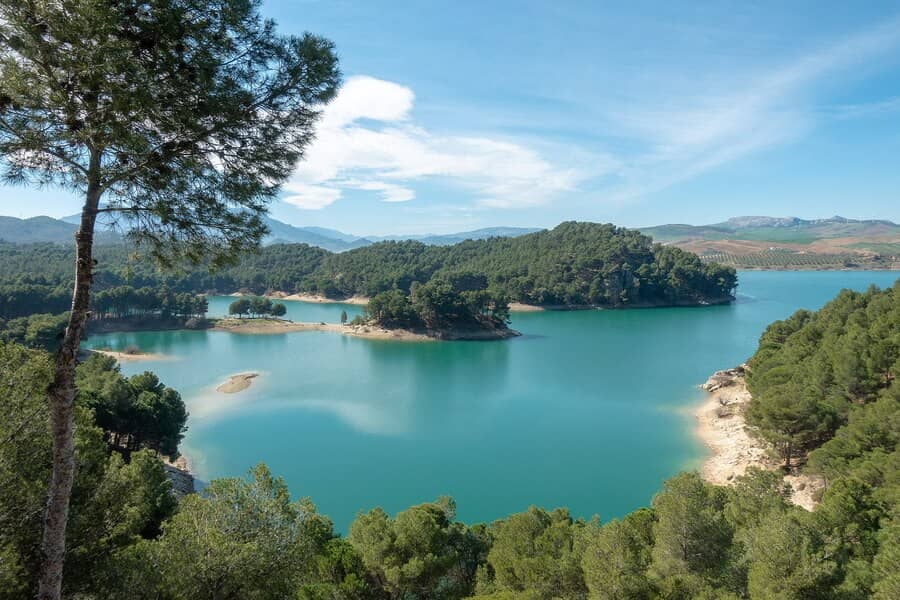
The Pantano del Chorro (also known as Embalse del Conde de Guadalhorce) is a reservoir located in the town of the same name, near Málaga in the South of Spain.
The reservoir is one of the most beautiful in Spain, with impressive views and beautiful limestone formations along its coast.
Swimmers can enjoy kilometres of beaches and hidden coves, and there are many opportunities to practice water sports like kayaking, SUPing and canoeing.
The surrounding mountains offer a lot of hiking and cycling routes for when you get bored with lounging around, and the nearby white villages of Álora and Ardales are also worth a visit! Because the Pantano del Chorro is located near the world-famous Caminito del Rey, you can easily combine a visit to the two: get your adrenaline high at the Caminito in the morning, and relax in the afternoon on the shore of the reservoir.
Pantano del Chorro
Address: 29320, Málaga
Coordinates: 36.9499992, -4.8254215
- Garganta de los Infiernos | 15,000 searches per month
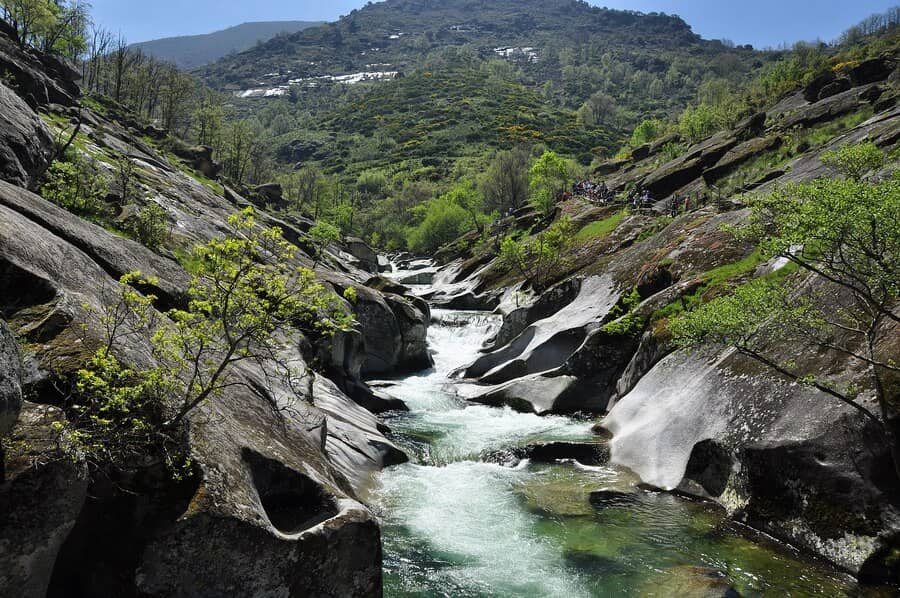
The Garganta de los Infiernos (lit. the throat of Hell) is located in Extremadura, in the natural park of the same name.
While the park has plenty of rivers and natural pools where you can dip into the water, the actual Garganta de los Infiernos, also called Los Pilones, is the most famous swimming spot.
It consists of a series of natural pools carved into granite by the river. To get to the Garganta de los Infiernos you will have to hike a route of 3 kilometres that will bring you right to the natural pools, where you can cool down in the cold water.
And it’s definitely worth braving the cold to swim in one of the most spectacular wild swimming pools in Spain! If you still have energy left on your way back, why not take a detour and discover the rest of this beautiful natural park?
Garganta de los Infiernos
Address: 10612 Cabezuela del Valle, Cáceres
Coordinates: 40.1904498, -5.6837949
- Cueva del Gato | 13,000 searches per month
The Cueva del Gato is a popular wild swimming pools in Andalusia. Located 15 kilometres from the famous town Ronda, this cave attracts plenty of visitors in the summer months.
The cave is the entrance to a 10-kilometre-long, partially flooded cave system, one of the most complex in the region.
While experienced spelunkers can explore the cave system if they ask permission from the local authorities, wild swimming fans prefer to stay at the natural pool of Cueva del Gato, where the water reaches the surface.
Enjoy the cool water with views of the Sierra de Grazalema, or go on a hike and discover some of the other, smaller natural pools of the area!
Cueva del Gato
Address: MA-7401 Km 3 Carretera de, 29370 Benaoján, Málaga
Coordinates: 36.727413, -5.238552
- Las Lagunas de Neila | 5300 searches per month
The Lagunas de Neila are a series of lakes in Burgos, in the Sierra de la Demanda. These glacial lakes are not for the feint-hearted: at an altitude of 1700 metres the water is quite cold even in summer!
But if you decide to brave the cold (or bring a wetsuit), you can enjoy a swim with incredible views of the highest peak in the mountain range and the surrounding landscape.
If you take a short hike from the lakes, you will stumble upon natural pools carved out in the rock. They are connected by waterfalls and are another popular wild swimming spot of the Lagunas de Neila!
Lagunas de Neila
Address: 09679, Burgos
Coordinates: 41.933917, -2.7616188
- La Foradada | 5200 searches per month
La Foradada is a natural pool with an impressive waterfall of 15 metres high in Cantonigròs, to the west of Girona. It has exceptionally clear water, and is sheltered from winds by high rock walls.
To get to La Foradada you will have to walk a trail for about 20 minutes that takes you through the beautiful Collsacabra Valley until you spot the rocks of La Foradada.
It’s a wonderful place to spend a day relaxing in the water! Alternatively, you may choose to continue your hike and reach the top of the waterfall to enjoy the view of the pool and the surrounding area.
La Foradada
Address: Camí de la Foradada, 08569, Barcelona
Coordinates: 42.0407047, 2.3946574
- Fuente Caputa | 5000 searches per month
Fuente Caputa is a real hidden gem of Spain! Located in the Murcia region at 40 minutes from the capital, these natural pools of different sizes are not frequently visited by locals, which means there is a good chance of having the pools all to yourself! The pools or pozas are all at slightly different heights and connected by little waterfalls.
The largest, Poza Grande, is the most popular swimming location, but the smaller pools located a little further are also great for lounging and cooling down.
There are also a couple of beautiful hikes in the area that will take you from Fuente Caputa to the nearby Pantano de la Cierva, another secret wild swimming spot.
Fuente Caputa
Address: 30193 Mula, Murcia
Coordinates: 38.079439, -1.5006361
- Salto de Bierge | 4200 searches per month
The Salto de Bierge, located in the Sierra de Guara in Huesca, is a natural pool with a waterfall of 10 metres high. With crystal clear water and beautiful views of the forest and mountains surrounding it, this spot is very popular with locals in the summer months.
It is also the endpoint of many canyoning routes of the area. The Salto de Bierge has two pools, one at the top of the waterfall and one at the bottom, with small areas for sunbathers.
If you fancy exploring the surroundings of the pools, they are the starting point of many hikes of varying difficulty that will take you on a tour of the stunning Sierra de Guara.
Salto de Bierge
Address: A-1227, 22144 Bierge, Huesca
Coordinates: 42.1714161, -0.090307
Wild Swimming guidelines
To ensure that the wild swimming experience is and stays enjoyable for you and others, please follow these guidelines:
- Be careful if the water is very cold, as that can cause cold water shock. If the water is cold, enter gradually to see how your body reacts, or use a wetsuit
- Be aware of strong currents
- Do not enter caves, especially underwater ones
- Do not jump into the water before knowing the depth
- Do not swim alone
- Bring water shoes or beach shoes, since there can be sharp and/or slippery rocks in some places
- Be respectful of other swimmers
- Be respectful of the environment
- Don’t take unnecessary risks, use common sense
